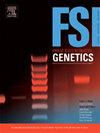包含9000个snp的捕获测序面板的开发和验证,用于推断东亚人群的远亲
IF 3.1
2区 医学
Q2 GENETICS & HEREDITY
引用次数: 0
摘要
长期以来,推断远亲一直是法医学的一个重大挑战。最近,法医研究人员越来越关注单核苷酸多态性(snp)作为这一目的的有力工具。在这项研究中,我们开发并验证了一个包含9000个snp的捕获测序面板,专门用于推断东亚人群中的远亲。最初,我们从四个数据源中筛选了9000个snp: Infinium全球筛选阵列、Infinium中国基因分型阵列、单核苷酸多态性数据库和1000基因组计划。随后,我们利用汉族人群的家系基因分型数据建立了基于似然比(LR)的算法。接下来,我们利用杂交捕获测序技术构建了9000个snp的测序方法。最后,根据DNA分析方法科学工作组(SWGDAM)的验证指南对9000个SNP面板进行评估,包括重复性、一致性、敏感性、物种特异性、PCR抑制、DNA降解、DNA混合和案例类型样本的研究。结果表明,9000个单核苷酸多态性在东亚人群中表现出明显的遗传多态性,平均小等位基因频率为0.4521。使用GSA SNP阵列进行家谱基因分型,9000个SNP被证明可以可靠地识别到5度和某些6度的亲属。此外,9000 SNP小组对痕量DNA(1.953 ng),降解DNA(50 bp)和混合DNA(19:1比例)的基因分型结果稳健可靠,显示出特定的物种特异性和对PCR抑制的抗性。总之,本研究强调了9000个SNP面板在推断东亚人群远亲方面的巨大潜力,为法医应用提供了有价值的工具。需要在更大的样本量中进一步验证来证实我们的观察结果。本文章由计算机程序翻译,如有差异,请以英文原文为准。
Development and validation of a capture sequencing panel containing 9000 SNPs for inferring distant relatives in East Asian populations
Inferring distant relatives has long presented a significant challenge in forensic science. Recently, forensic researchers have increasingly focused on single nucleotide polymorphisms (SNPs) as a potent tool for this purpose. In this study, we developed and validated a capture sequencing panel comprising 9000 SNPs specifically aimed at inferring distant relatives within East Asian populations. Initially, we screened the 9000 SNPs from four data sources: the Infinium Global Screening Array, the Infinium Chinese Genotyping Array, the Single-Nucleotide Polymorphism database, and the 1000 Genomes Project. Subsequently, we established a likelihood ratio (LR)-based algorithm utilizing pedigree genotyping data from Han Chinese populations. Next, we constructed a sequencing method for the 9000 SNPs employing hybridization capture sequencing technology. Finally, the 9000 SNP panel was evaluated following the validation guidelines of the Scientific Working Group on DNA Analysis Methods (SWGDAM), including studies on repeatability, concordance, sensitivity, species specificity, PCR inhibition, DNA degradation, DNA mixture and casework-type samples. The results demonstrated that the 9000 SNPs exhibited considerable genetic polymorphism within East Asian populations, with an average minor allele frequency of 0.4521. The panel of 9000 SNPs was demonstrated to reliably identify relatives up to the 5th degree and certain 6th degree using the GSA SNP array for pedigree genotyping. Furthermore, the 9000 SNP panel yielded robust and reliable genotyping results for trace DNA (1.953 ng), degraded DNA (50 bp), and mixed DNA (19:1 ratio), showing specific species specificity and resistance to PCR inhibition. In conclusion, this study highlights the significant potential of the 9000 SNP panel for inferring distant relatives in East Asian populations, providing a valuable tool for forensic applications. Further validation in a larger sample size is needed to confirm our observations.
求助全文
通过发布文献求助,成功后即可免费获取论文全文。
去求助
来源期刊
CiteScore
7.50
自引率
32.30%
发文量
132
审稿时长
11.3 weeks
期刊介绍:
Forensic Science International: Genetics is the premier journal in the field of Forensic Genetics. This branch of Forensic Science can be defined as the application of genetics to human and non-human material (in the sense of a science with the purpose of studying inherited characteristics for the analysis of inter- and intra-specific variations in populations) for the resolution of legal conflicts.
The scope of the journal includes:
Forensic applications of human polymorphism.
Testing of paternity and other family relationships, immigration cases, typing of biological stains and tissues from criminal casework, identification of human remains by DNA testing methodologies.
Description of human polymorphisms of forensic interest, with special interest in DNA polymorphisms.
Autosomal DNA polymorphisms, mini- and microsatellites (or short tandem repeats, STRs), single nucleotide polymorphisms (SNPs), X and Y chromosome polymorphisms, mtDNA polymorphisms, and any other type of DNA variation with potential forensic applications.
Non-human DNA polymorphisms for crime scene investigation.
Population genetics of human polymorphisms of forensic interest.
Population data, especially from DNA polymorphisms of interest for the solution of forensic problems.
DNA typing methodologies and strategies.
Biostatistical methods in forensic genetics.
Evaluation of DNA evidence in forensic problems (such as paternity or immigration cases, criminal casework, identification), classical and new statistical approaches.
Standards in forensic genetics.
Recommendations of regulatory bodies concerning methods, markers, interpretation or strategies or proposals for procedural or technical standards.
Quality control.
Quality control and quality assurance strategies, proficiency testing for DNA typing methodologies.
Criminal DNA databases.
Technical, legal and statistical issues.
General ethical and legal issues related to forensic genetics.

 求助内容:
求助内容: 应助结果提醒方式:
应助结果提醒方式:


